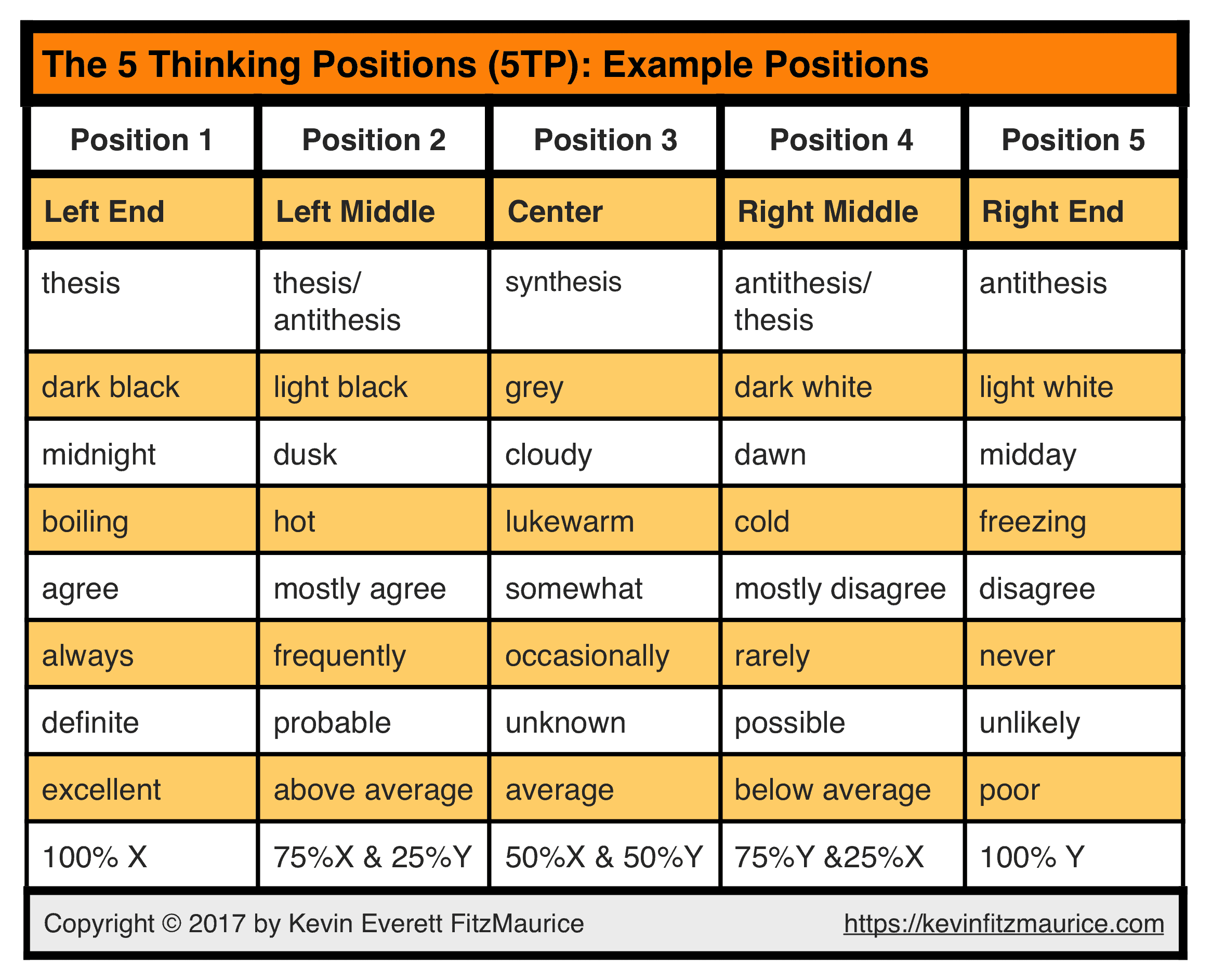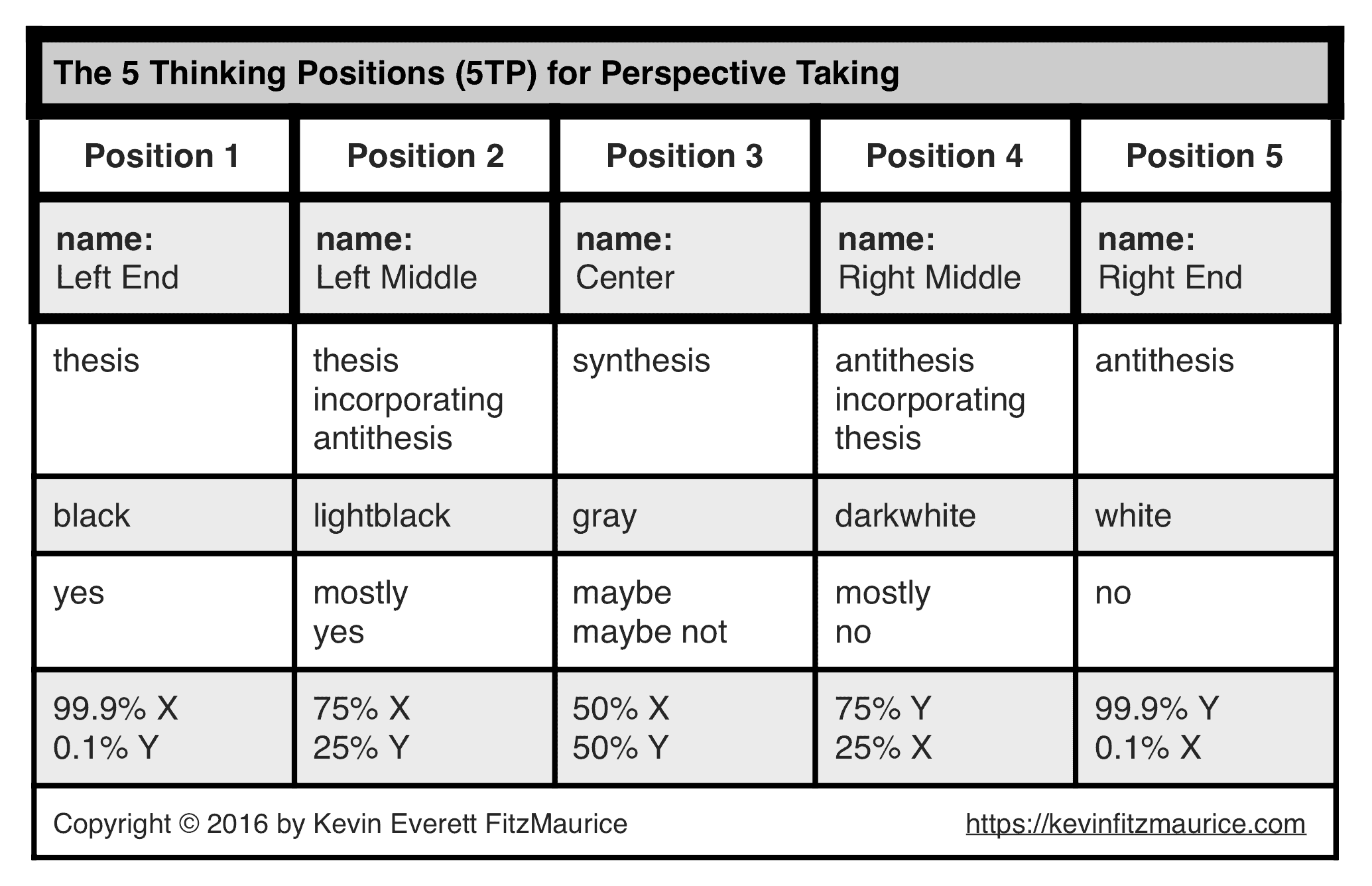The 5 Thinking Positions (5TP) Explained
- We’re All Insane! Second Edition will teach you how to think better and saner.
- Games Ego Plays will teach more about the 5TP.
- Discovery Demands 5TP: The Evolution of Perspective
The 5 Thinking Positions will teach you the life-skill skill of perspective-taking. Understand yourself, others, and life better by gaining perspective.
“Nothing is at last sacred but the integrity of your own mind.” —Ralph Waldo Emerson
“Let reason go before every enterprise, and counsel before every action.” —Ecclesiasticus 38:33
“There are five sides to every story.” —Kevin Everett FitzMaurice
“Tragedy is when I cut my finger; comedy is when you fall into a manhole and die.” —Mel Brooks
- Read and master the life skill of perspective-taking using the best system ever: the 5TP.
- The Five Thinking Positions (5TP) are explained with examples in this book.
The 5 Thinking Positions (5TP) Table
- Click for a list of pages on the 5TP.
- Read and master the life skill of perspective-taking using the best system ever: the 5TP.
- The Five Thinking Positions (5TP) are explained with examples in this book.
The 5 Thinking Positions (5TP)
5 Choice Minimum
There are always at least five choices, opinions, and versions regarding anything.
- Understanding that there are at least five options helps you be more open, flexible, tolerant, and honest in your thinking.
- If you realize there are always at least five choices, your decisions will be more likely to meet reality and be productive.
- If you comprehend that there are always at least five opinions on any topic, you will be more open to, tolerant of, and accepting of other people’s views.
- If you are aware that there are always at least five versions of any happening, then you are more likely to question authority, the news, propaganda, and TV and to think for yourself.
- Since the five positions exist on a continuum, an infinite number exists.
“There are two ways to slide easily through life: to believe everything or to doubt everything; both ways save us from thinking.” —Alfred Korzybski, Polish-American founder of General Semantics (1879–1950)
The 5 Thinking Positions (5TP)
5TP in Simple Terms of Positive & Negative
- Statements that are all negative about the topic.
- Statements that are mostly negative about the topic but that are not all negative.
- Statements that are all neutral about the topic.
- Statements that are mostly positive about the topic but that are not all positive.
- Statements that are all positive about the topic.
- Read and master the life skill of perspective-taking using the best system ever: the 5TP.
- The Five Thinking Positions (5TP) are explained with examples in this book.
The 5 Thinking Positions (5TP)
5TP Spelled Out
The five main thinking positions are:
- Thesis
- Thesis-incorporating-antithesis
- Synthesis
- Antithesis-incorporating-thesis
- Antithesis.
The 5 Thinking Positions (5TP)
5TP Common Example: Likert Scale
- The Likert Scale used in surveys is an everyday use of the 5TP.
- Strongly Disagree
- Disagree
- Neither Disagree nor Agree
- Agree
- Strongly Agree
“Finding a few rare or unusual cases to disprove a rule only works to prove that it is a reliable rule but not an absolute rule.” —Kevin Everett FitzMaurice
- Read and master the life skill of perspective-taking using the best system ever: the 5TP.
- The Five Thinking Positions (5TP) are explained with examples in this book.
The 5 Thinking Positions (5TP)
Notes on the 5TP
- All five of these positions contain some truth, some data that the others leave out. However, only one of these five positions often accurately fits most of the available data.
- For instance, most day-to-day reality on Earth falls into two of the five positions: thesis-incorporating-antithesis and antithesis-incorporating-thesis.
- Another way to say this is that when we are not examining fine details or discussing overarching principles, then thesis-incorporating-antithesis and antithesis-incorporating-thesis usually fit the data best.
- But dichotomies (thesis and antithesis) are the most accurate and relevant on both the largest and smallest views of life.
- The logic of this is perfect: at the extremes, we find the extreme positions working best, and in the middle ground, we find the middle or general principles working best.
- Finally, it is important to understand that synthesis is the rarest position of all. Why is synthesis so rare? Because the true normal, the perfect average, rarely exists by itself. Usually, what people refer to as a synthesis is not a true synthesis but the experience of either thesis-incorporating-antithesis or antithesis-incorporating-thesis.
- It is also important to know that synthesis is not inherently good. For instance, Jihadists are a synthesis of good and evil impulses that provide psychological freedom and certainty: the ideal of an Islamic state is combined with hate and revenge.
- Persistently practice looking for all five positions, especially when you favor only one.
The 5 Thinking Positions (5TP)
Bell Curve, Distribution Curve, Normal Curve
- Those familiar with statistics can easily relate the paradigm of the five-thinking positions to the “normal curve” or what some call the bell-shaped distribution curve. For example, synthesis can be considered to be the mean or median.
- Dichotomies (thesis and antithesis) can be considered to be found in the space occurring two or three standard deviations from the mean.
- That is, the thesis can be found in the space occurring two or three standard deviations from the left of the mean, and the antithesis can be found in the space occurring two or three standard deviations from the right of the mean.
- The thesis-incorporating-antithesis can be found in the space one or two standard deviations from the mean to the left (negative standard deviation).
- The antithesis-incorporating-thesis can be found in the space one or two standard deviations from the mean to the right (positive standard deviation).
The 5 Thinking Positions (5TP)
5TP Group Exercise
- Using five chairs, have each member of a group move in and out of each chair while expounding the position of each chair (5TP) on a controversial topic.
- Each member states all five views only once.
- Read and master the life skill of perspective-taking using the best system ever: the 5TP.
- The Five Thinking Positions (5TP) are explained with examples in this book.
The 5 Thinking Positions (5TP)
5TP Basic or Generic Examples
- Click to go to the book on the 5TP.
The 5 Thinking Positions (5TP)
Perspective-Taking Skills
- Click to go to the book on the 5TP.
“To pretend that a few rare or unusual cases constitute a rule is to claim that exceptions and variations are better standards than the standards they vary from.” —Kevin Everett FitzMaurice
The 5 Thinking Positions (5TP)
5-Stage Evolution of Perspective-Taking
- Click for the book on how to master the 5TP.
- Read and master the life skill of perspective-taking using the best system ever: the 5TP.
- The Five Thinking Positions (5TP) are explained with examples in this book.
The 5 Thinking Positions (5TP)
Example Uses of The 5 Thinking Positions (5TP)
- 5 Survival Styles
- 5 Thinking Styles
- 25 Relational Styles Using 5TP
- Downloadable PDF Table: Example Words for 5TP
- Passive to Aggressive Using 5TP
- Simple Circle Diagram 5TP
- Discover Games Ego Plays to learn about the 5 Thinking Positions (5TP) and human games.
- Read and master the life skill of perspective-taking using the best system ever: the 5TP.
- The Five Thinking Positions (5TP) are explained with examples in this book.
The 5 Thinking Positions (5TP)
Quotations Various Sources
Listed Alphabetically
“A mature person is one who does not think only in absolutes, who is able to be objective even when deeply stirred emotionally, who has learned that there is both good and bad in all people and in all things.” —Eleanor Roosevelt
“All language is dualistic.” —J. Krishnamurti, Can Humanity Change? p. 22
“All opposites are born of their own opposites.” —J. Krishnamurti, Can Humanity Change? p. 23
“Any man who is under 30 and is not a liberal has not heart; and any man who is over 30 and is not a conservative has no brains.” —Sir Winston Churchill, 1874-1965
“Can a man cling to the positive without any negative in contrast to which it is seen to be positive? If he claims to do so, he is a rouge or a madman.” —Chung Tzu
“Duality is necessary for things but deadly for self.” —Kevin Everett FitzMaurice
“Goodness is not born of badness.” —J. Krishnamurti, Can Humanity Change? p. 22
“I am saying anything born out of its opposite contains its opposite.” —J. Krishnamurti, Can Humanity Change? p. 24
“I’m not sure I want popular opinion on my side–I’ve noticed those with the most opinions often have the fewest facts.” —Bethania McKenstry
“If fifty million people say a foolish thing, it is still a foolish thing.” —Anatole France
“If we could learn how to balance rest against effort, calmness against strain, quiet against turmoil, we would assure ourselves of joy in living and psychological health for life.” —Josephine Rathbone
“Let reason go before every enterprise, and counsel before every action.” —Ecclesiasticus 38:33
“Life is a tragedy when seen in close-up, but a comedy in long-shot.” —Charlie Chaplin
“Nothing is more certain than uncertainties: / Fortune is full of fresh variety; / Constant in nothing but inconstancy.” —Richard Barnfield
“Real knowledge is to know the extent of one’s ignorance.” — Confucius
“The heart has its reasons which reason knows nothing of.” —Blaise Pascal
“The worst extreme view is the extreme view that extremes never exist.” —Kevin Everett FitzMaurice
“There are two tragedies in life. One is to lose your heart’s desire. The other is to gain it.” —George Bernard Shaw
“There are two ways to slide easily through life; to believe everything or to doubt everything. Both ways save us from thinking.” —Alfred Korzybski
“There is no such thing as absolute certainty, but there is assurance sufficient for the purpose of human life.” —John Stuart Mill
“To be absolutely certain about something, one must know everything, or nothing, about it.” —Olin Miller
“To say dualism is bad or wrong is the worst kind of dualism.” —Kevin Everett FitzMaurice
“We can be absolutely certain only about things we do not understand.” —Eric Hoffer
- Read and master the life skill of perspective-taking using the best system ever: the 5TP.
- The Five Thinking Positions (5TP) are explained with examples in this book.
The 5 Thinking Positions (5TP)
Related Pages of Free Information
- 5 Thinking Positions (5TP): Fast-Facts
- 5 Thinking Positions (5TP): List Pages
- Continuum Thinking
- Counseling Issues: REBT’s 11 Irrational Beliefs
- Developmental Stages (8) of Thinking
- Thinking Skills: 7 Errors of CT
- Thinking Skills: Both-And Skill
- Thinking Skills: Free Help
- Thinking Skills: Limitations of Thought
- Triality: Move Beyond Duality
Book Devoted to 5TP
- Read and master the life skill of perspective-taking using the best system ever: the 5TP.
- The Five Thinking Positions (5TP) are explained with examples in this book.
- Read and master the life skill of acceptance using the best combination of CBT, REBT, & Stoicism.
The 5 Thinking Positions (5TP)
6 Groups of Topics Menu
- 1. Pages by Topic
- 2. Fast-Facts by Topic
- 3. Quotations by Topic
- 4. Poems by Topic
- 5. Scripture by Topic
- 6. Websites by Topic
- Read and master the life skill of acceptance using the best combination of CBT, REBT, & Stoicism.
- Read and master the life skill of perspective-taking using the best system ever: the 5TP.
- The Five Thinking Positions (5TP) are explained with examples in this book.
The 5 Thinking Positions (5TP)
10 Skills & Topics Menu
- 1. Coping Skills & Topics
- 2. Problem-Solving Skills & Topics
- 3. Communication Skills & Topics
- 4. Recovery Skills & Topics
- 5. Anger Skills & Topics
- 6. Blame Skills & Topics
- 7. Thinking Skills & Topics
- 8. Responsibility Skills & Topics
- 9. Counseling Skills & Topics
- 10. Praying Skills & Topics
- Read and master the life skill of acceptance using the best combination of CBT, REBT, & Stoicism.
- Read and master the life skill of perspective-taking using the best system ever: the 5TP.
- The Five Thinking Positions (5TP) are explained with examples in this book.







